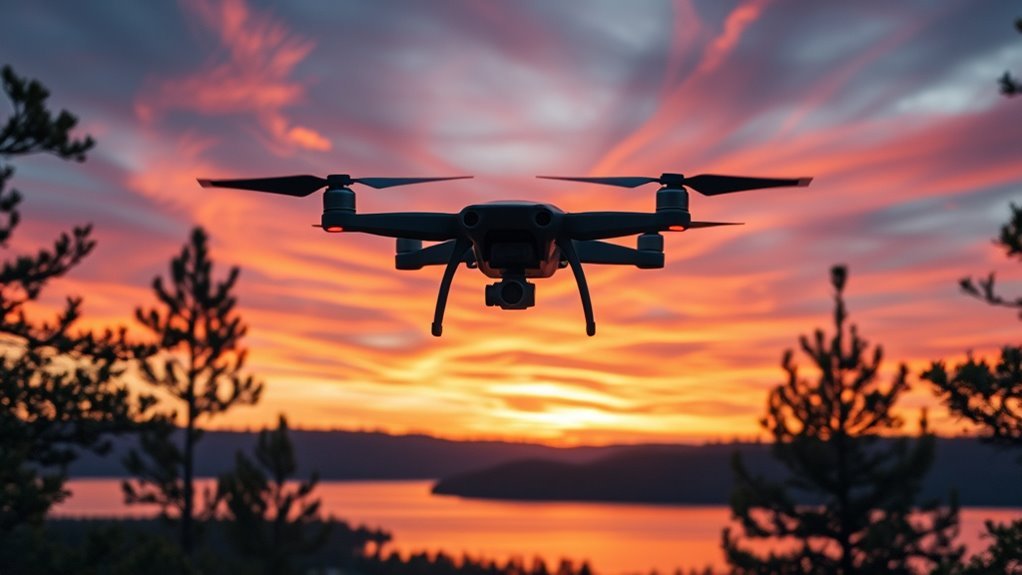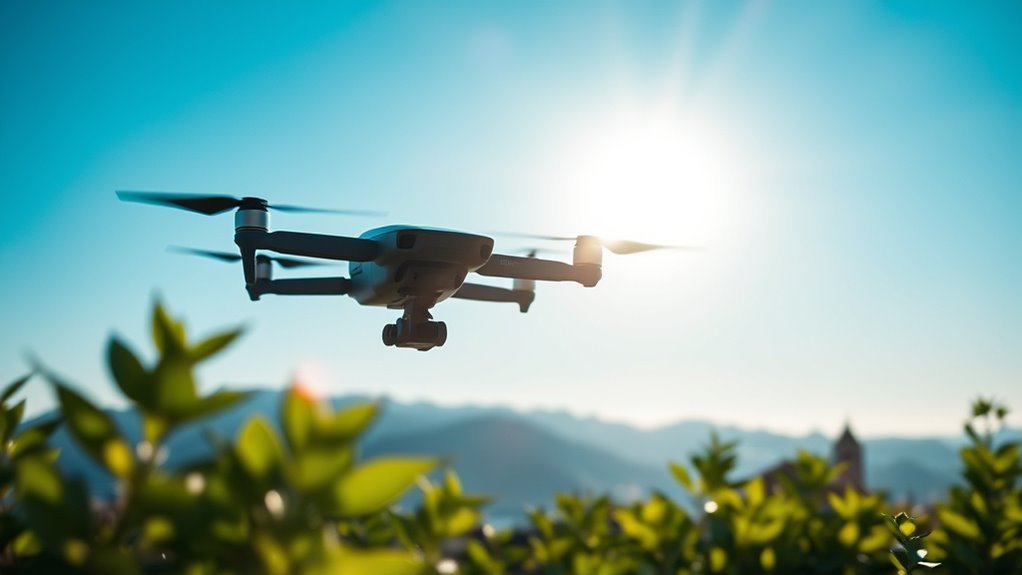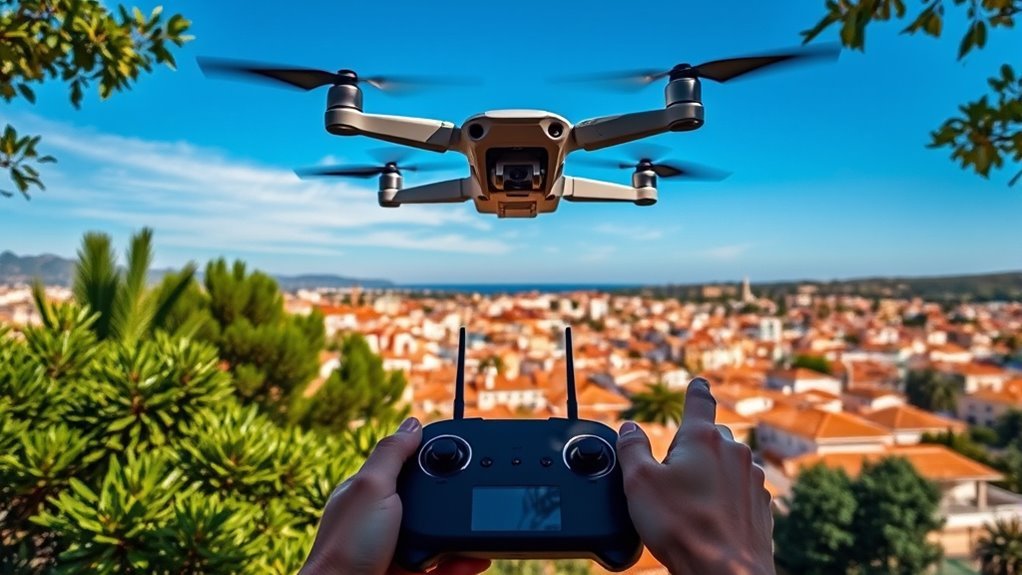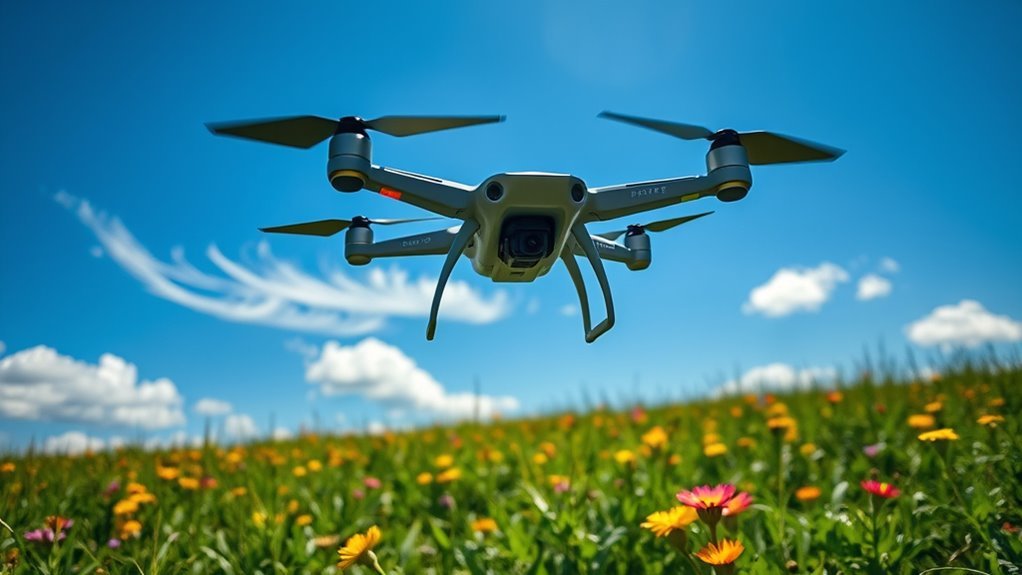The word “drone” translates to “drón” in Spanish, a term widely accepted across Spanish-speaking regions. While “drón” is standard, you might come across variations like “vehículo aéreo no tripulado” in Latin America or “juguete volador” in the Caribbean. These regional nuances can enrich your understanding of drone terminology. If you’re curious about the evolution of drone technology and its diverse applications, there’s more information to explore on that front.
The Spanish Translation of Drone

When discussing the term “drone” in Spanish, it’s vital to highlight that the direct translation is “drón.” This term is used universally in contexts involving unmanned aerial vehicles, whether for recreational, commercial, or military purposes. Understanding drone terminology is essential for anyone interested in this rapidly evolving field. While “drón” is widely accepted, regional variations do exist. For instance, in some Latin American countries, you might hear “droncito” affectionately, referring to smaller models. These subtle differences can reflect local cultures and practices. By familiarizing yourself with these terms, you empower yourself to engage more effectively in discussions surrounding drones, expanding your knowledge and appreciation for this technology that offers unprecedented freedom and capabilities.
Common Terms Used for Drones in Different Regions

While “drón” is the standard term for drones in Spanish, various regions have unique colloquialisms that reflect local language nuances. In Spain, you might hear “dron” pronounced with a softer ‘o’, while in Latin America, terms like “vehículo aéreo no tripulado” (VANT) are often used, emphasizing the technical aspect. In some Caribbean nations, you may encounter playful terms that highlight the drone’s role in leisure, such as “juguete volador.” These regional variations in drone terminology illustrate how local cultures influence language. Understanding these differences not only enhances communication but also enriches your appreciation for the diverse linguistic landscape surrounding drone technology. Adapting to these terms can empower you in conversations about this rapidly evolving field.
The Evolution of Drone Technology

You’ll find that the evolution of drone technology is marked by significant historical milestones that have shaped its current applications. From early military uses to civilian innovations, understanding these developments is essential for anticipating future trends in UAVs. As technology continues to advance, the potential for drones in various sectors expands, making this a critical area of exploration. Notably, the integration of AI and autonomous systems is revolutionizing how drones are utilized, enhancing efficiency and effectiveness across diverse applications. The advancements in tactical camera quality have further broadened the operational capabilities of drones, allowing for enhanced decision-making in various scenarios.
Historical Milestones in Drones
As technology evolved, so did the concept of drones, which have shifted from simple remote-controlled aircraft to sophisticated tools employed in various fields. The drone history is marked by significant military applications, dating back to World War I when early unmanned aerial vehicles were used for target practice. Fast forward to the late 20th century, advancements in GPS and imaging technology transformed drones into crucial assets for reconnaissance and surveillance. By the 21st century, they became essential in various sectors, including agriculture, logistics, and disaster response. These historical milestones highlight how drones have expanded their roles, reflecting society’s increasing reliance on technology to enhance operational efficiency and gather critical data, ultimately promoting freedom in data accessibility and decision-making.
Future Trends in UAVs
With the rapid advancement of technology, the future of unmanned aerial vehicles (UAVs) promises to be transformative across multiple sectors. You’ll likely see the rise of autonomous navigation systems, enabling drones to operate independently in complex environments. This shift could enhance efficiency and reduce human error, making UAVs invaluable for industries like agriculture, logistics, and surveillance. Additionally, swarm technology is set to revolutionize how drones collaborate, allowing them to work together seamlessly to cover vast areas or perform intricate tasks. Imagine drones coordinating in real-time to deliver supplies or monitor wildlife. Embracing these innovations will not only enhance operational capabilities but also empower individuals and businesses to explore new possibilities in aerial operations. The future looks promising!
Drones in Photography and Videography
Drones have revolutionized the fields of photography and videography, offering unprecedented perspectives and creative possibilities. You can capture stunning aerial shots that were once only achievable with helicopters or cranes, making drone photography an essential tool for professionals and enthusiasts alike. The ability to maneuver in tight spaces and reach high altitudes allows for unique compositions that showcase landscapes, events, and architecture from angles that inspire. EXO’s cameras provide exceptional image quality and versatility, enhancing your aerial photography experience. Aerial videography, on the other hand, enhances storytelling through dynamic shots that engage viewers. With advancements in technology, you’re now able to access high-resolution cameras and stabilization systems, ensuring professional-quality results. Embracing these tools expands your creative freedom, enabling you to push the boundaries of visual storytelling like never before. In addition, Hubsan cameras offer cost-effective solutions for capturing compelling footage, making them ideal for budget-conscious creators.
Agricultural Applications of Drones
When you consider agricultural applications, drones are transforming how farmers monitor crops and manage resources. With their ability to provide precision crop monitoring, detect pests and diseases early, and optimize irrigation, these technologies enhance efficiency and productivity. Understanding these uses can greatly impact agricultural practices and sustainability. Drones like the Guardian Agriculture Drone offer advanced features such as multispectral sensors for improved crop health analysis, which include advanced nozzle technology for precision spraying.
Precision Crop Monitoring
Precision crop monitoring has revolutionized agricultural practices, enabling farmers to optimize yields and reduce resource waste. By utilizing drones, you can gather essential data that enhances decision-making. Here are three key benefits:
- Enhanced Crop Yield: Drones provide real-time insights, allowing for targeted interventions that maximize output.
- Data Analysis: High-resolution imagery and analytics help identify areas needing attention, promoting efficient resource allocation.
- Sustainability: Using drones minimizes environmental impact by optimizing water and fertilizer use, leading to more sustainable farming practices.
As you embrace these advancements, you’ll find that precision crop monitoring not only increases productivity but also supports a more responsible approach to agriculture, allowing you to thrive in today’s competitive landscape.
Pest and Disease Detection
By leveraging advanced imaging technology, farmers can effectively detect pests and diseases in their crops before they become widespread issues. This proactive approach enhances pest management strategies, enabling you to target specific areas that need intervention rather than applying treatments indiscriminately. Drones equipped with multispectral cameras can monitor plant health, allowing for early disease surveillance and identification of pest infestations. By analyzing the data collected, you can make informed decisions that improve crop yields and reduce chemical usage. This not only protects your investment but also promotes sustainable agricultural practices. With drones, you’re empowered to maintain healthier crops and guarantee the long-term viability of your farming operations, ultimately giving you greater freedom in managing your agricultural landscape.
Efficient Irrigation Management
Efficient irrigation management is essential for optimizing water usage and ensuring crop health in agriculture. Drones play a pivotal role in this process, enabling farmers to implement sustainable agriculture practices and enhance water conservation. Here are three key benefits of using drones for irrigation management:
- Precision Monitoring: Drones provide real-time data on soil moisture levels, allowing you to adjust irrigation schedules accurately.
- Targeted Irrigation: With aerial imagery, you can identify specific areas needing more or less water, reducing waste and promoting healthier crops.
- Time Efficiency: Automating irrigation assessments saves you time, letting you focus on other critical aspects of farming.
Legal Regulations Surrounding Drones in Spanish-speaking Countries
As countries in the Spanish-speaking world increasingly adopt drone technology, the legal landscape surrounding its use has become more complex and varied. You’ll find that drone regulations differ considerably from one nation to another, shaped by unique legal frameworks and societal needs. Understanding these rules is essential if you wish to operate drones responsibly.
| Country | Key Regulation | Licensing Requirement |
|---|---|---|
| Spain | Must register with AESA | Pilot license required |
| Mexico | Restricted near airports | No specific license needed |
| Argentina | Governed by ANAC | Pilot license required |
Navigating these regulations can be challenging, but staying informed will empower you to fly with confidence.
Cultural Perceptions of Drones in Latin America
While many view drones as technological marvels with vast potential, cultural perceptions in Latin America often reflect a mix of fascination and skepticism. You might find that these attitudes are shaped by various factors:
- Symbolism of Surveillance: Drones can symbolize oppression, reminding communities of invasive monitoring.
- Hope for Innovation: Many see drones as tools for progress, offering solutions in agriculture and disaster response.
- Concerns Over Safety: There’s an ongoing worry about accidents and misuse, which can create public backlash.
These cultural attitudes towards drones illustrate a broader dialogue about freedom and autonomy. As you navigate this complex landscape, understanding these perceptions can offer valuable insight into how technology is embraced or challenged in different contexts across Latin America.
The Future of Drones in Spanish-speaking Markets
Understanding the cultural perceptions of drones sets the stage for exploring their future in Spanish-speaking markets. As these emerging markets embrace technological adoption, you’ll find diverse applications for drones in agriculture, logistics, and surveillance. Drones can facilitate real-time monitoring of crops, which enhances agricultural efficiency and sustainability.
| Market | Current Usage | Future Potential |
|---|---|---|
| Mexico | Delivery services | Precision farming |
| Colombia | Mining operations | Environmental monitoring |
| Argentina | Media coverage | Disaster response |
| Chile | Wildlife tracking | Infrastructure inspection |
The increasing demand for efficiency and innovation will likely drive growth. By understanding regional needs, companies can tailor their drone technologies, fostering a sense of freedom and advancement in these dynamic markets. Additionally, leveraging precision farming techniques will enhance agricultural productivity and sustainability in these regions. The possibilities are vast, and the future looks promising.
Frequently Asked Questions
What Are the Different Types of Drones Available in Spanish-Speaking Countries?
In Spanish-speaking countries, you’ll find various drones, including drones comerciales for business applications and drones recreativos for personal enjoyment. Each type serves unique purposes, catering to different interests and needs within the drone community.
How Do You Pronounce “Drone” in Spanish?
When you’re considering the pronunciation of “drone” in Spanish, focus on regional variations. In many areas, it’s pronounced like “dron.” For pronunciation tips, emphasize the short “o” sound, ensuring clarity and accuracy in your speech.
Are There Synonyms for “Drone” in Spanish?
You’d think there’s a million ways to express “drone” in Spanish! While “dron” is the standard term, you might encounter synonyms like “vehículo aéreo no tripulado,” showcasing the rich drones terminology and various drone equivalents in Spanish.
What Is the History of Drones in Spanish-Speaking Cultures?
In Spanish-speaking cultures, drone evolution reflects technological progress and cultural significance. You’ll find that drones symbolize both innovation and surveillance, influencing artistic expression, social movements, and the pursuit of freedom, reshaping perceptions of privacy and security.
How Are Drones Referred to in Popular Media in Spanish?
In popular media, drone terminology emphasizes their multifaceted roles, from surveillance to entertainment. Their representation often sparks discussions about privacy and technology, reflecting societal anxieties while showcasing their potential for creativity and innovation.

